| Home | Nature Weekly Index |
27 September 2015 | Syrphid Fly Larva (Hoverfly, Flower Fly) | Syrphidae |
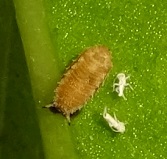
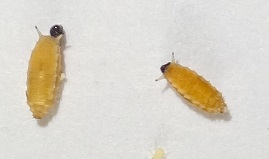 Two weeks back, I shared the discovery of syrphid fly larva on the leaves of my
hibiscus plant located at the balcony area. A few days later after the
sighting, I was no longer able to locate them. This week, I started to find more of them, at least 5, on the plant. On top of that,
there were another type of tiny creature, about 2 millimetres (mm) long, on the leaves. This new creature was orange in colour, with
a black dot at one end and 2 spikes. It was much smaller in size than the syrphid fly larva. At first, I thought the black dot
was the head region and it was the early stage of the syrphid fly larva. After observing these orange creatures for several days,
they appeared to be immobile. Finally, I took 2 of them to have a closer examination yesterday. When I broke one up, there was
orange fluid flowing out. It now looked more like pupa to me judging from the shape and the liquid content. It remained to be
determine whether they were syrphid fly pupa. I am contemplating to keep the pupa in a sealed container to check on the adult fly.
Two weeks back, I shared the discovery of syrphid fly larva on the leaves of my
hibiscus plant located at the balcony area. A few days later after the
sighting, I was no longer able to locate them. This week, I started to find more of them, at least 5, on the plant. On top of that,
there were another type of tiny creature, about 2 millimetres (mm) long, on the leaves. This new creature was orange in colour, with
a black dot at one end and 2 spikes. It was much smaller in size than the syrphid fly larva. At first, I thought the black dot
was the head region and it was the early stage of the syrphid fly larva. After observing these orange creatures for several days,
they appeared to be immobile. Finally, I took 2 of them to have a closer examination yesterday. When I broke one up, there was
orange fluid flowing out. It now looked more like pupa to me judging from the shape and the liquid content. It remained to be
determine whether they were syrphid fly pupa. I am contemplating to keep the pupa in a sealed container to check on the adult fly.
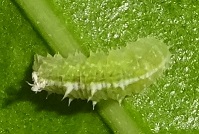
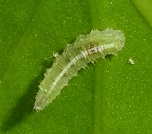 As for the syrphid fly larva, it was about 8 mm long. The whole body was green in colour with a white stripe running through the
length of its body. There were also spikes on its body. But unlike the tiny orange creature, there were many more spikes.
As for the syrphid fly larva, it was about 8 mm long. The whole body was green in colour with a white stripe running through the
length of its body. There were also spikes on its body. But unlike the tiny orange creature, there were many more spikes.
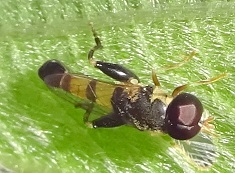 At one occasion, I did see a small syrphid fly hovering near the hibiscus plant. As it never stopped on any object and flew away
relatively quick, there was no chance to even take a glimpse of its appearance. Nevertheless, while I was exploring in the park
last week, I saw at least 2 small syrphid flies hovering around a
Glory Bush (Pleroma urvilleanum). Since I was then very keen to get some
pictures of this fly, I waited and hoping that they would take a break soon. In fact, one of them did; under one of the leaf. I
managed to take some pictures but only one of them turn out to be of average quality. The small size of the fly made it really
tough to take a good picture with my existing equipment. The fly had a pair of swollen hind legs, similar to that seen with
Sphegina species. It could potentially be the adult of the larva seen on my plant since the park was just next to my home.
At one occasion, I did see a small syrphid fly hovering near the hibiscus plant. As it never stopped on any object and flew away
relatively quick, there was no chance to even take a glimpse of its appearance. Nevertheless, while I was exploring in the park
last week, I saw at least 2 small syrphid flies hovering around a
Glory Bush (Pleroma urvilleanum). Since I was then very keen to get some
pictures of this fly, I waited and hoping that they would take a break soon. In fact, one of them did; under one of the leaf. I
managed to take some pictures but only one of them turn out to be of average quality. The small size of the fly made it really
tough to take a good picture with my existing equipment. The fly had a pair of swollen hind legs, similar to that seen with
Sphegina species. It could potentially be the adult of the larva seen on my plant since the park was just next to my home.
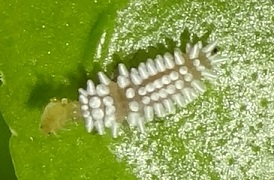 Syrphid fly belongs to the insect family Syrphidae and hence, its common name. It is more often call hover fly due to its flight
pattern, which kind of like a helicopter hovering in the air. As for the name flower fly, it is likely resulted from its association
with flowers.
Syrphid fly belongs to the insect family Syrphidae and hence, its common name. It is more often call hover fly due to its flight
pattern, which kind of like a helicopter hovering in the air. As for the name flower fly, it is likely resulted from its association
with flowers.
Today, while surveying the situation on the hibiscus plant, I spotted a tiny white colour creature that looked like a mealy bug, except that its length was twice the size of the typical mealy bugs seen. After viewing the photo taken in an enlarged version, I thought it might be another species of syrphid fly larvae. But, when it started moving on the leaf, the movement resembled more of a ladybird beetle larva. Indeed, it might be a Scymnus species, a group of small black, brown, mottled or spotted beetles. From the picture, the larva was seen holding onto an aphid at its head region.